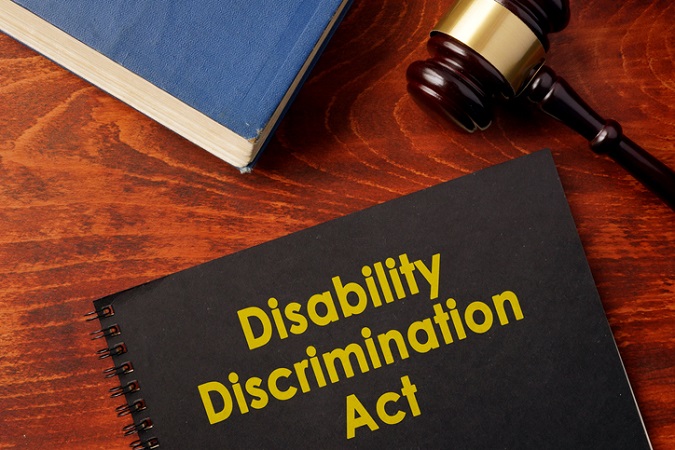Disability in the UK
According to the 2018/19 Family Resources Survey, there are 14.1 million disabled people in the United Kingdom. 8% of children are disabled, 19% of working adults are disabled, and 44% of pensionable age adults are disabled.
Statistics (as detailed in the Statistics section below) showed that the rates of higher education, employment, and home ownership amongst disabled people were in 2020, notably lower than the general population. Figures from the Office of National Statistics also showed disabled people to be significantly more likely to suffer both anxiety and abuse.
According to the Campaign Group, Scope, in 2017, 32% of disabled people and 22% of non-disabled people felt there was a lot of prejudice against disabled people.
The gap between the two groups had trebled from a similar survey in 2000 which showed that 37% of disabled people and 34% of non-disabled people felt that there was a lot of prejudice around disability.



The Equality Act took over from the Disability Discrimination Act as the dominant legislation in 2010.
What is disability discrimination?
The Disability Discrimination Act 1995 described a disabled person as someone with “a physical or mental impairment which has a substantial and long-term adverse effect on his or her ability to carry out normal day-to-day activities”, which has or can be expected to last for more than 12 months.
Conditions that impair an individual’s abilities in this way include those that hamper mobility; manual dexterity; physical co-ordination; continence; the ability to lift; carry or move everyday objects; speech; hearing or eyesight; memory or ability to concentrate, learn or understand; and understanding of the risk of physical danger. For the purposes of the law, apart from with spectacles and contact lenses, treatment and correction are not taken into account.
Discrimination occurs when a disabled person receives unfavourable treatment compared to a non disabled person, and that treatment is for a reason relating to the person’s disability, and the treatment cannot be justified. Discrimination also occurs when there is a failure to make a reasonable adjustment for a disabled person, and that failure cannot be justified. Discrimination can involved direct discrimination or indirect disability discrimination.
The Disability Discrimination Act was replaced by the Equality Act 2010 which provides for the protection of disabled people from direct and indirect discrimination.
Background
The Disability Discrimination Act 1995 was the first domestic Act relating to the issue of disability discrimination, prior to which it was legal to discriminate and exclude on the basis of disability.
The Act covered a variety of areas of disability discrimination law, from employment law to access to transport. This Act also set up the National Disability Council, which was abolished when the Disability Rights Commission was established in April 2000.
The Disability Rights Commission was replaced in October 2007 by the Equality and Human Rights Commission, which is now responsible for the work of three former equality commissions: the Commission for Racial Equality, the Equal Opportunities Commission and the Disability Rights Commission.
Since the Disability Discrimination Act, the UK government has been working with the disabled community to ensure its members are able to participate fully in society. The main areas of focus have been education, employment, reasonable accommodation, welfare provision and transport.
In 2001, the Disability Discrimination Act (DDA) was extended into the public sector to cover (among other things) the police, prison service and fire service. The Equal Treatment in Employment Directive required the Government to ensure that all employers, except for the armed forces, would come under the auspices of the Disability Discrimination Act by 2004.
The Disability Discrimination Act 2005 made further substantial amendments to the Disability Discrimination Act 1995 building on amendments made previously by other legislation.
In November 2001, the UN General Assembly established an Ad Hoc Committee (AHC) to “consider proposals for a comprehensive and integral convention on the rights and dignity of persons with disabilities.” Subsequently, work began to establish an international disability convention.
On 13th December 2006, the Convention on the Rights of Persons with Disabilities and its Optional Protocol was adopted at the United Nations Headquarters in New York, and was opened for signature on 30th March 2007. The Convention entered into force on 3rd May 2008.
A major new piece of research on disability in Britain was launched in March 2009 as part of the Government’s long-term aim to achieve equality in all areas for people with disabilities. The Life Opportunities Survey (LOS), carried out by the Office for National Statistics on behalf of the Office for Disability Issues (ODI), compared the activities of disabled and non-disabled people in various situations, such as at work, in education, playing sports, and using transport and public services. It also looked at living standards, housing, discrimination and crime.
The Life Opportunities Survey is a longitudinal survey which means it will interview the same people over a number of years in order to assess whether or not life opportunities for people with disabilities are improving. The results of the first annual survey were published in December 2010.
Legal protection for disabled people was transferred from the Disability Discrimination Act to the Equality Act with effect from October 2010. The Equality Act defines a disabled person as someone who has a physical or mental impairment, that has a substantial and long-term adverse effect on their ability to carry out normal day-to-day activities.
The Equality Act provides protection from discrimination in areas such as employment, education, access to goods, services and facilities, and buying and renting land or property. The Act also provides protection from discrimination for people associated with a disabled person, such as a parent or carer.
Progressive conditions such as HIV, cancer, multiple sclerosis and some visual impairments are also covered by the Act.
According to figures from the Ministry of Justice, the number of disability discrimination claims brought before an employment tribunal in relation to discrimination legislation rose to 6,550 in 2018, a 37 per cent increase on the previous year.
A discrimination claim can relate to the treatment of a job applicant, harassment and victimisation of a disabled worker, or unfavorable treatment relating to an employee’s disability.
Controversies
Given the high costs and complexity of disability litigation, the issue of enforcing legal rights that protect against discrimination courted controversy when the Disability Discrimination Act was first introduced.
A report published by the Royal National Institute for the Blind in 2000, entitled ‘The Price of Justice’, criticised the framework of protection at the time, suggesting the high costs involved in pursuing claims of discrimination in the provision of goods, services and facilities effectively blocked access to justice in some cases, and called for a review of the way these claims are brought. The report called for greater use of the employment tribunal system and more effective training of judges in disability related issues.
On the other side, small business groups expressed concern around the costs of complying with the Disability Discrimination Act. They argued that these costs were high, particularly when modifications to buildings and vehicles were needed. Given the wording of the Act, it is clear that what “can be justified” was the key variable – and the issue of what proportionate means is hotly contested.
Outside of the availability of legal action against explicit discrimination, campaigners have highlighted considerable prejudices against disabled people and various barriers to their participation in many areas of life.
One particularly unpleasant aspect of prejudice against disabled people is ‘disability hate crime’. Several cases have been reported in the press over recent years and all have attracted public outrage. A particularly tragic case was that of 38 year old Fiona Pilkington who, after suffering years of abuse by local youths, killed herself and her 18 year old disabled daughter, by setting fire to the car they were in. Ms Pilkington had complained to the police more than 30 times to no avail and subsequent independent inquiries strongly criticised both the police and local authorities for failing to stop the campaign of terror.
The then Director of Public Prosecutions (and now Labour Party Leader), Sir Keir Starmer, in a speech in March 2011 spoke of the “very many” disability hate crimes that the Crown Prosecution Service deals with every year. At the time, Sir Keir said there was “clear evidence” that disability hate crime was widespread and he believed “many thousands of cases” go unreported year on year.
In his then role, Starmer claimed that the number of cases brought, the number of individuals charged and the number of successful prosecutions is much lower for disability hate crime than for racial, religious, or homophobic hate crime. He also noted that there is no offence of inciting hatred based on disability, whereas there is for inciting hatred based on race, religion, or sexual orientation.
Employment is another controversial area. The Government’s decision to close 36 out of 54 Remploy factories in March 2012 attracted severe criticism. Remploy factories were established over 60 years ago and provide work for people with disabilities.
The national disability charity Livability, whilst accepting that loss-making factories may have to be closed, was concerned about the “urgency” with which it was being done. Chief executive Mike Smith warned: ”In the current economic climate and with high levels of unemployment, this will be devastating news for thousands of disabled people and their families…..More time and support should be allowed for Remploy’s disabled workforce to find other employment.”
Livability also urged the Government to be “more innovative” in finding employment for disabled people. The charity claimed the Access to Work programme was “not effective and not value for money” and suggested that more support should instead be given to self-employment programmes.
In October 2011, eight national disability charities came together to launch Disability Works UK, a not-for-profit consortium which aims to provide tailored employment support to disabled people. In February 2012, DWUK announced that it had secured a number of sub-contracts to deliver the Work Programme, the government initiative to help long-term unemployed and disabled people into work. However, United Response, one of the charities involved, stressed that DWUK would only seek contracts “with providers whose values are compatible with our own” and would play no role in the imposition of sanctions, as they believed that sanctions “do not incentivise disabled people to look for work, nor do they give them the confidence”.
There have also been controversies around the treatment of disabled pupils in the mainstream education system, and of disabled students within Higher Education.
Statistics
23.0% of disabled people aged 21 to 64 years in the UK had a degree as their highest qualification compared with 39.7% of non-disabled people; 15.1% of disabled people had no qualifications compared with 5.4% of non-disabled people.[Source: Office for National Statistics – 2020]
Around half of disabled people aged 16 to 64 years (52.1%) in the UK were in employment compared with around 8 in 10 (81.3%) for non-disabled people. Disabled people with autism were among those disabled people with the lowest employment rate.[Source: Office for National Statistics – 2020]
Disabled people aged 16 to 64 years in the UK were less likely to own their own home (40.9%) than non-disabled people (53.4%).[Source: Office for National Statistics – 2020]
Average anxiety levels were higher for disabled people at 4.47 out of 10, compared with 2.91 out of 10 for non-disabled people.[Source: Office for National Statistics – 2020]
The proportion of disabled people (13.9%) aged 16 years and over in England, who reported feeling lonely “often or always” was almost four times that of non-disabled people (3.8%). [Source: Office for National Statistics – 2020]
Around 1 in 7 (14.3%) disabled people aged 16 to 59 years in England and Wales experienced domestic abuse in the last 12 months, compared with about 1 in 20 (5.1%) non-disabled people.
[Source: Office for National Statistics – 2020]
Life costs £583 more on average a month if you’re disabled – [Source, Scope, The Disability price tag, 2019]
After housing costs, the proportion of working age disabled people living in poverty (26%) is higher than the proportion of working age non-disabled people (20%). [Source: Scope’s analysis based on Households Below Average Income Data, 2017 to 2018]
Quotes
“Disability hate crime strikes at all disabled people by undermining their sense of safety and security in the community. For this reason disability hate crime should be regarded as particularly serious. Such crimes are based on ignorance, prejudice, discrimination and hate and they have no place in an open and democratic society.” Keir Starmer, 2011, speaking as Director of Public Prosecutions
“In today’s Britain people with disabilities (including those with profound and complex needs) should be supported to make a full and meaningful contribution to our society. We believe that all stakeholders should work to ensure that barriers preventing them from doing so are eliminated.” – The Disabilities Trust










